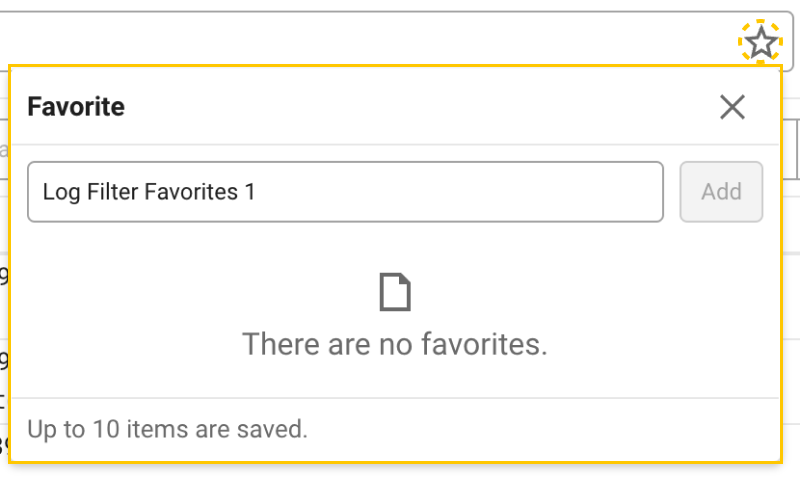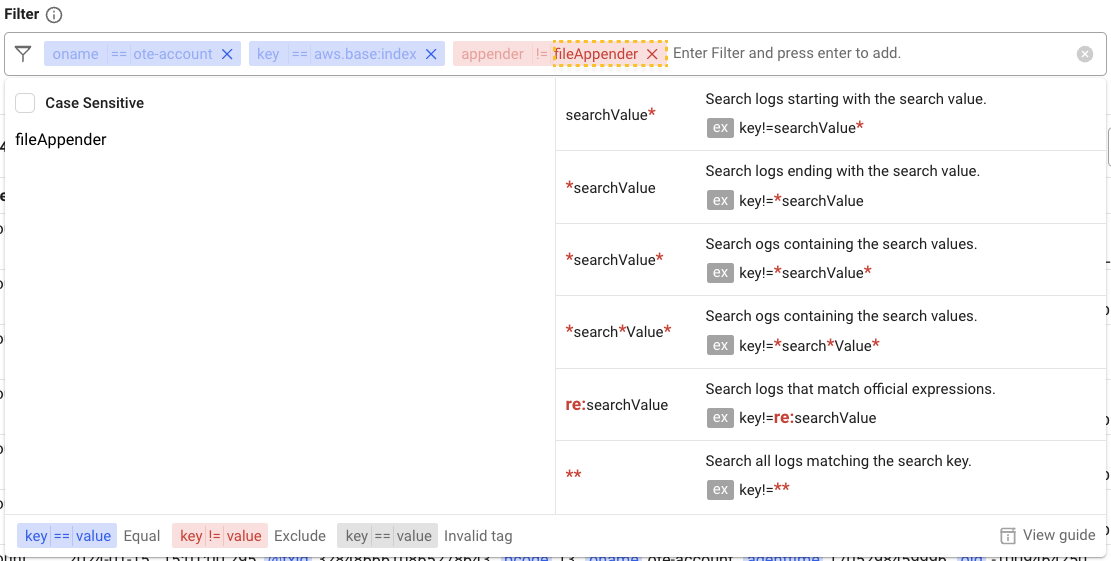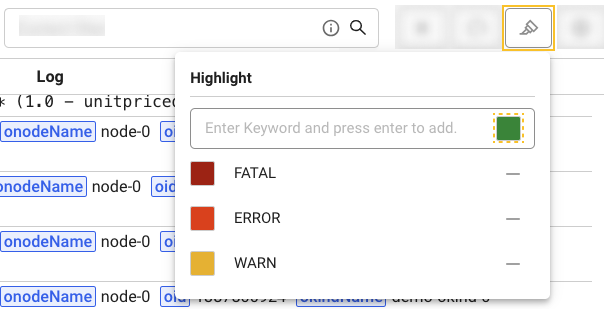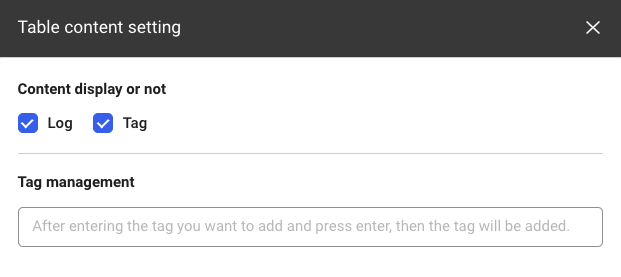Live Tail
Without the Log Read role, you cannot enter the menu.
Home > Select Project > Dashboard > Live Tail
In Live Tail, you can easily check the log data stream on the monitoring screen without accessing the server console. You can select necessary logs from numerous logs and quickly recognize the desired logs through the highlight function.

In Live Tail, complex logs can be easily accessed. You can search the logs in real time by using the functions such as Filter or Highlight, if necessary. The log data search cycle is 2 seconds.
The major terms are as follows:
- Category: Unit for log collection and inquiry
- Content: Log messages
- Search Key: It is generated through the log parser settings.
- Tag: Key to search the collected logs
You can change the column width by dragging an edge of the log table column.
Agent option
If the agent option is set, the log levels are collected and the colors for each log level appear as follows:

Setting the agent options
-
The agent options are as follows:
# whatap.conf
weaving=log4j-2.17
weaving=logback-1.2.8 -
In Java agent 2.2.22 or later, it can be used when setting log4j-2.17 or logback-1.2.8 in the weaving setting. It is required to restart the agent.
-
The log level is determined based on the
levelandtypeamong the parsed keywords. When there are keys parsed aslevelandtype, and the parsed values have FATAL, CRITICAL, ERROR, WARN, WARNING, and INFO, the log level color appears.
 Filter area
Filter area
Apply Filter
When a filter is applied, the logs that match the specified conditions are filtered. You can enter multiple filters. OR (||) if the filters have the same tags, otherwise AND (&&).
You can specify a filter by directly entering a value in the input field or clicking the Filter field. Filter tags are entered in the following order: Search key, Operator, and Search value. If you select Search, the data with the filter applied can be viewed in the
area.
Guide UI
The Guide UI is provided under the input field as follows: You can close the Guide UI via the ESC key when your mouse cursor is over the input field or filter tag.

Entry of the search key, operator, and search value
-
Upon entry of the
search key, recommended values are provided by distinguishing for general index, reserved word index, and numeric index. -
When entering an
operator, for a general index search key,==and!=options are provided at the bottom. In case of the numeric index, the>,<,<=,>=,==, and!=options are provided. -
Upon entry of the
search valuefor matched search (>,<,<=,>=,==), it is highlighted in blue, In case of excluded search (!=), it is highlighted in red. -
Upon entry of the
search value, you can search using the case-sensitive option.
-
If the filter tags exceed 2 lines, you can fold it by selecting the
Fold icon.
-
After entering a filter tag, you can use the Shift and Tab keys simultaneously in the input field to go to the previous filter tag.
-
After entering a filter tag, you can use the Tab key in the input field to go to the next filter tag.
Adding filter tags
-
You can enter text in the input field and add then add more items by using the Enter key or Tab key on your keyboard.
-
You can add recommended values by clicking them in the Guide UI below the input field.
-
In the Guide UI below the input field, you can select recommended values with the up/down arrow keys on the keyboard and add tags by using the Enter and Tab keys.
Deleting filter tags
-
A tag can be deleted with the Backspace key.
-
You can delete a tag by selecting the X icon for it.
-
You can delete all tags by selecting the Delete All X icon in the input field.
Filter favorites
The filter favorites feature is provided. You can select the Favorites icon on the right of the input window to add, delete, and select desired filter search conditions in the favorites. Favorites can store up to 50 cases.

Exceptional cases for application of filters
-
In the tag with a numeric index (
search keythat ends with.n), only numbers can be input for thesearch value. -
Duplicate ‘search key’ and ‘search value’ cannot be entered.
-
Searching is not possible if there is a tag whose
search keyorsearch valueis missing. Invalid tags appear in gray.
-
You cannot enter a
categorywith the Live Tailsearch key. -
The expression under the entered filter value is a preview of the filter expression for querying the log data.
Applying non-parsing keyword filters
You can search the logs containing keywords that have not been parsed, or for which no index has been created. In this case, all logs in the specified range are fully scanned. Therefore, the search speed may be slower compared to the indexed key. For standardized log data, it is recommended to search using the index key through Log parser setting.

-
Select Category.
-
In the Filter field, enter a desired keyword for a search after leaving spaces on the
contentbasis.e.g.
content *select* -
Click
Search to view the logs.
- In case of Live Tail, all logs can be viewed. Thus, the category is not required to be specified.
-
For more information about the parser configuration, see the following.
Modifying the filter
Enter a value in the filter and then click the specified value to modify it.

-
You can modify the filter by entering text again in the input field.
-
You can modify the recommended values by selecting them in the Guide UI below the input field.
Search Key
In the following image, the blue boxed part is the search key for parsing. In Log Configuration, you can register and set the parsing logic in Log parser setting tab with the search key.

Filter input syntax
A tag consists of a search key and a search value. In the following example, the search key is exception and the search value is UnknownHostException. The example searches for the log data that includes an exception (UnknowHostException) that is generated when the server cannot connect the host because the IP address and domain address do not match among the collected log data.
Search key types
| Search key types | Search key format | Meaning | Example for Search key and search value | Seach example |
|---|---|---|---|---|
| String keyword | keyword | File Name | - Key: fileName - Value: /data/whatap/logs/yard.log | fileName:/data/whatap/logs/yard.log |
| Numeric keyword | keyword.n | Response Time | - Key: response_time.n - Value: 2945 | response_time.n>=2945 |
| Reserved keyword (predefined keyword) | @keyword | Transaction ID | - Key: @txid - Value: 85459614215434144 | - |
| Log body's keyword | content | Log body | - Key: content - Value: user input | content: *ERROR* |
Content search key
-
The content search key searches the bodies of unindexed logs. For example, if you enter
content *ERROR*, the logs containingERRORare searched among the log bodies. -
If you do not know which keywords need to be used for indexing, use the content search keys to identify the logs containing problematic keywords. Afterwards, you can improve the search performance by setting a parser with the keyword through the log parser settings in Log Configuration and creating indexes.
Common syntaxes
| Syntax type | Description | Example |
|---|---|---|
==searchValue | Searches for the logs that match the search value. | exception==RuntimeExceptionexception |
!=searchValue | Searches for the logs that exclude the search value. | exception!=RuntimeException |
*searchValue | Searches for the logs ending with the search value. | word==*hello |
searchValue* | Searches for the logs starting with the search value. | word==hello* |
*searchValue* | Searches for the logs that contain the search value in the middle. | word==*hello* |
*search*Value* | Searches for the logs that contain the search value. | word==*he*llo* |
re:{regexr} | Searches for the logs that match a regular expression. | caller==re:^i\.w\.a\.w\.s\.v\.r\. |
** | Searches all logs that match the search key. |
Syntax in case the search key has a numeric value (keyword.n)
The following syntax is supported only when the search key is in keyword.n format.
-
Search values must only be numbers.
-
No prefix is attached to the value of the
.nkeyword. All keywords other than.nmust be attached with a prefix.For example,
+>searchValueis invalid.
| Syntax type | Description | Example |
|---|---|---|
>searchValue | Searches for the logs containing values greater than the search value. | response_time.n>3000 |
>=searchValue | Searches for the logs containing values greater than or equal to the search value. | response_time.n>=3000 |
==searchValue | Searches for the logs containing the same search value. | response_time.n==3000 |
!=searchValue | Searches for the logs that contain values different from the search value. | response_time.n!=3000 |
<searchValue | Searches for the logs containing values less than the search value. | response_time.n<3000 |
<=searchValue | Searches for the logs containing values less than or equal to the search value. | response_time.n<=3000 |
 Content highlight area
Content highlight area
The highlight function is provided to easily identify the desired keywords among the log data.

-
In the
keyword field, enter a keyword to highlight, and then click
Search.
e.g.
select -
As shown in the example, the keyword within the content is highlighted in the
log list.
-
You can filter by single or multiple keywords.
-
If you select
Log full screen, the Log and Timestamp appear in the full screen.
Multi-keyword condition
When highlighting with multiple keywords, write as follows:
| String to input | Description | Result |
|---|---|---|
a b c | Separate each keyword with a space. | a, b, c |
"Whatap is good." | To include spaces in keywords, wrap them in '' or "". | Whatap is good. |
"Whatap\\ is good." | If \ is included in the keyword surrounded by "", enter it as \\. | Whatap\ is good. |
Setting the highlight color
By selecting Highlight, you can set the keyword and its color for highlighting.

-
In addition, enter the keyword to set the color for.
-
If you click Color on the left of the input field, available colors appear.
-
Basically, different highlighting by the level (WARN, ERROR, FATAL) is applied.
-
The settings are saved in Project Rules.
Table settings
Column settings
Right of the ![]() area, select
area, select Column settings. You can add columns or set order.
-
Adding columns
You can add columns to the table by selecting tags. If you unselect the log column, you cannot see Log view detail setting. Be sure to select at least one column.
-
Setting the column order
When you add a column, the column is added to Display columns. Drag a desired column to change the order of the columns.
Log view detail setting

On the right of ![]() , select
, select Log view detail setting. content and Tag are all checked and two items are also displayed. Be sure to select any of content and Tag.
Unchecked items are not displayed in the table. If you deselect the Tag as follows, the log's Tag does not appear in the table.

When you add tags in the Tag management list, the tags in the log are listed in the order you added. You can change the order of the tags by dragging them. f you disable an added tag, the disabled tag does not appear.
-
Column settings and Log view detail setting can be used in Live Tail, Log Search, and Log Trend.
-
In the same project, the Live Tail, Log Search, and Log Trend menus share Column settings and Log view detail setting.